大英博物馆的大中庭Foster_Partners.pdf
- 格式:pdf
- 大小:6.37 MB
- 文档页数:5
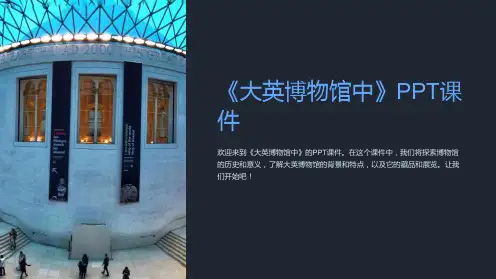
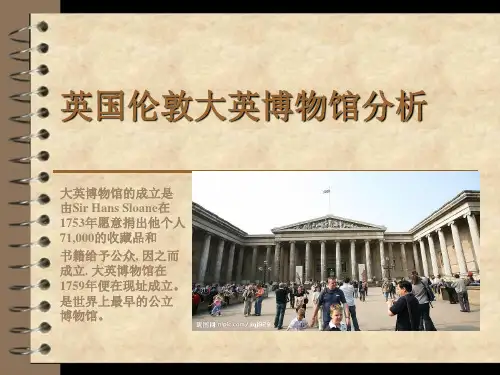
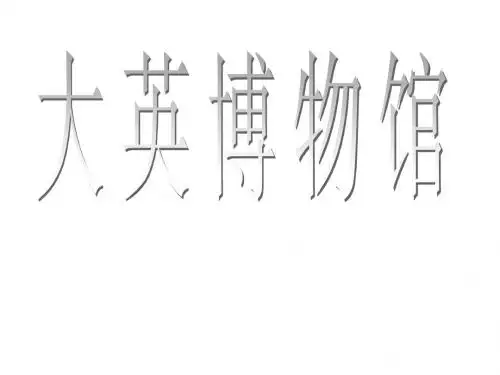
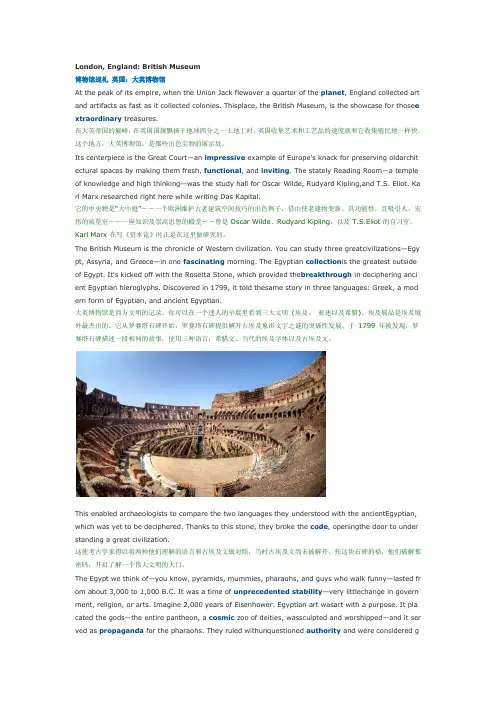
London, England: British Museum博物馆巡礼英国:大英博物馆At the peak of its empire, when the Union Jack flewover a quarter of the planet, England collected art and artifacts as fast as it collected colonies. Thisplace, the British Museum, is the showcase for those e xtraordinary treasures.在大英帝国的巅峰,在英国国旗飘扬于地球四分之一土地上时,英国收集艺术和工艺品的速度就和它收集殖民地一样快。
这个地方,大英博物馆,是那些出色宝物的展示处。
Its centerpiece is the Great Court—an impressive example of Europe's knack for preserving oldarchit ectural spaces by making them fresh, functional, and inviting. The stately Reading Room—a temple of knowledge and high thinking—was the study hall for Oscar Wilde, Rudyard Kipling,and T.S. Eliot. Ka rl Marx researched right here while writing Das Kapital.它的中央物是“大中庭”--一个欧洲维护古老建筑空间技巧的出色例子,借由使老建物变新、具功能性,且吸引人。
宏伟的阅览室--一座知识及崇高思想的殿堂--曾是 Oscar Wilde、Rudyard Kipling,以及 T.S.Eliot 的自习室。
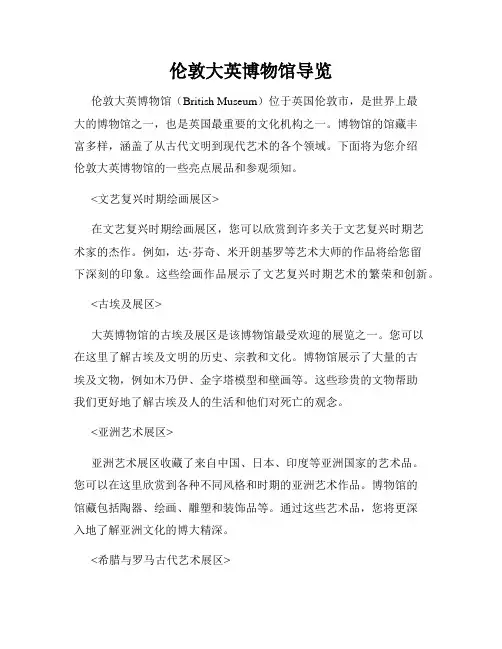
伦敦大英博物馆导览伦敦大英博物馆(British Museum)位于英国伦敦市,是世界上最大的博物馆之一,也是英国最重要的文化机构之一。
博物馆的馆藏丰富多样,涵盖了从古代文明到现代艺术的各个领域。
下面将为您介绍伦敦大英博物馆的一些亮点展品和参观须知。
<文艺复兴时期绘画展区>在文艺复兴时期绘画展区,您可以欣赏到许多关于文艺复兴时期艺术家的杰作。
例如,达·芬奇、米开朗基罗等艺术大师的作品将给您留下深刻的印象。
这些绘画作品展示了文艺复兴时期艺术的繁荣和创新。
<古埃及展区>大英博物馆的古埃及展区是该博物馆最受欢迎的展览之一。
您可以在这里了解古埃及文明的历史、宗教和文化。
博物馆展示了大量的古埃及文物,例如木乃伊、金字塔模型和壁画等。
这些珍贵的文物帮助我们更好地了解古埃及人的生活和他们对死亡的观念。
<亚洲艺术展区>亚洲艺术展区收藏了来自中国、日本、印度等亚洲国家的艺术品。
您可以在这里欣赏到各种不同风格和时期的亚洲艺术作品。
博物馆的馆藏包括陶器、绘画、雕塑和装饰品等。
通过这些艺术品,您将更深入地了解亚洲文化的博大精深。
<希腊与罗马古代艺术展区>希腊与罗马古代艺术展区展示了古希腊和古罗马时期的艺术品。
这些艺术品反映了古希腊和古罗马的建筑、雕塑和壁画等方面的重要成就。
例如,卡里亚忒琴雕像和巴尔达科斯之冠等都是该展区的瞩目之作。
参观须知:1. 入馆时间:伦敦大英博物馆每天上午10点开馆,下午5点闭馆(周五延长至晚上8点)。
请提前规划好您的参观时间,以充分利用您在博物馆的时间。
2. 入场费用:大英博物馆入场免费,但部分特殊展览可能需要额外费用。
3. 包裹和背包:为了保护博物馆的文物,不允许携带大型背包和行李进入博物馆。
请将您的物品放置在指定的存放处。
4. 拍照和录像:大英博物馆允许游客拍照和录像,但禁止使用闪光灯和三脚架。
请尊重其他游客的参观体验。
在您游览伦敦大英博物馆时,请您注意保持文物的安全和整洁,遵守博物馆的规定和指示。
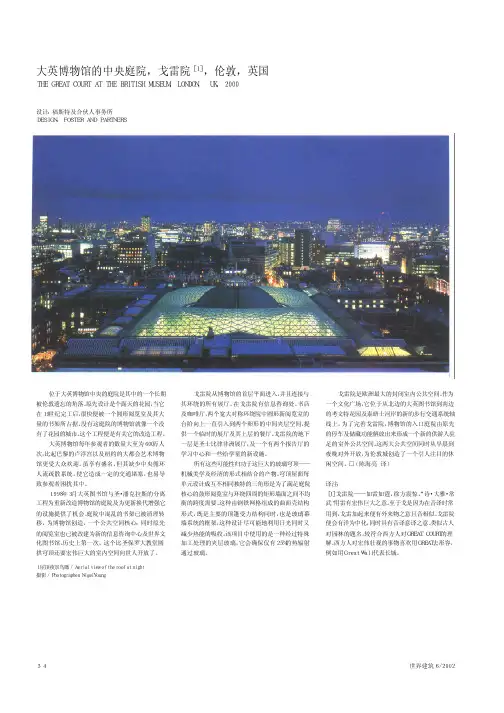
位于大英博物馆中央的庭院是其中的一个长期被伦敦遗忘的角落。
原先设计是个露天的花园,当它在19世纪完工后,很快便被一个圆形阅览室及其大量的书架所占据。
没有这庭院的博物馆就像一个没有了花园的城市。
这个工程便是有关它的改造工程。
大英博物馆每年参观者的数量大至为600万人次,比起巴黎的卢浮宫以及纽约的大都会艺术博物馆更受大众欢迎。
虽享有盛名,但其缺少中央循环人流疏散系统,使它造成一定的交通堵塞,也易导致参观者困扰其中。
1998年3月大英图书馆与圣・潘克拉斯的分离工程为重新改造博物馆的庭院及为更新换代增强它的设施提供了机会。
庭院中混乱的书架已被清理转移,为博物馆创造,一个公共空间核心:同时原先的阅览室也已被改建为新的信息咨询中心及世界文化图书馆。
历史上第一次, 这个比圣保罗大教堂圆拱穹顶还要宏伟巨大的室内空间向世人开放了。
设计:福斯特及合伙人事务所DESIGN: FOSTER AND PARTNERS大英博物馆的中央庭院,戈雷院[1],伦敦,英国THE GREAT COURT AT THE BRITISH MUSEUM, LONDON, UK, 2000戈雷院从博物馆的首层平面进入,并且连接与其环绕的所有展厅。
在戈雷院有信息咨询处、书店及咖啡厅。
两个宽大对称环绕院中圆形新阅览室的台阶向上一直引入到两个卵形的中间夹层空间,提供一个临时的展厅及其上层的餐厅。
戈雷院的地下一层是圣士比律非洲展厅,及一个有两个报告厅的学习中心和一些给学童的新设施。
所有这些可能性归功于这巨大的玻璃穹顶——机械美学及经济的形式相结合的产物。
穹顶屋面每单元设计成互不相同独特的三角形是为了满足庭院核心的鼓形阅览室与环绕四周的矩形墙面之间不均衡的跨度需要。
这种由钢铁网格组成的曲面壳结构形式,既是主要的顶篷受力结构同时,也是玻璃幕墙系统的框架,这种设计尽可能地利用日光同时又减少热能的吸收。
该项目中使用的是一种经过特殊加工处理的夹层玻璃,它会确保仅有25%的热辐射通过玻璃。
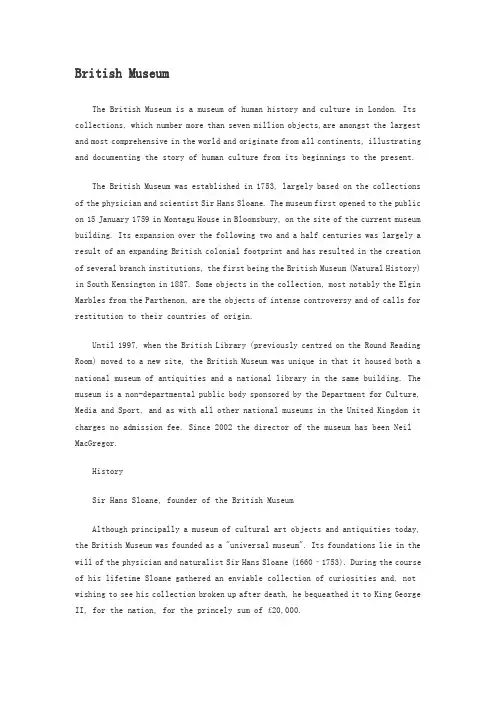
British MuseumThe British Museum is a museum of human history and culture in London. Its collections, which number more than seven million objects,are amongst the largest and most comprehensive in the world and originate from all continents, illustrating and documenting the story of human culture from its beginnings to the present.The British Museum was established in 1753, largely based on the collections of the physician and scientist Sir Hans Sloane. The museum first opened to the public on 15 January 1759 in Montagu House in Bloomsbury, on the site of the current museum building. Its expansion over the following two and a half centuries was largely a result of an expanding British colonial footprint and has resulted in the creation of several branch institutions, the first being the British Museum (Natural History) in South Kensington in 1887. Some objects in the collection, most notably the Elgin Marbles from the Parthenon, are the objects of intense controversy and of calls for restitution to their countries of origin.Until 1997, when the British Library (previously centred on the Round Reading Room) moved to a new site, the British Museum was unique in that it housed both a national museum of antiquities and a national library in the same building. The museum is a non-departmental public body sponsored by the Department for Culture, Media and Sport, and as with all other national museums in the United Kingdom it charges no admission fee. Since 2002 the director of the museum has been Neil MacGregor.HistorySir Hans Sloane, founder of the British MuseumAlthough principally a museum of cultural art objects and antiquities today, the British Museum was founded as a "universal museum". Its foundations lie in the will of the physician and naturalist Sir Hans Sloane (1660–1753). During the course of his lifetime Sloane gathered an enviable collection of curiosities and, not wishing to see his collection broken up after death, he bequeathed it to King George II, for the nation, for the princely sum of £20,000.At that time, Sloane’s collection consisted of around 71,000 objects of all kinds[8] including some 40,000 printed books, 7,000 manuscripts, extensive natural history specimens including 337 volumes of dried plants, prints and drawings including those by Albrecht Dürer and antiquities from Egypt, Greece, Rome, the Ancient Near and Far East and the Americas.Foundation (1753)On 7 June 1753, King George II gave his formal assent to the Act of Parliament which established the British Museum.The Foundation Act, added two other libraries to the Sloane collection. The Cottonian Library, assembled by Sir Robert Cotton, dated back to Elizabethan times and the Harleian library, the collection of the Earls of Oxford. They were joined in 1757 by the Royal Library, assembled by various British monarchs. Together these four "foundation collections" included many of the most treasured books now in the British Library including the Lindisfarne Gospels and the sole surviving copy of Beowulf.The British Museum was the first of a new kind of museum – national, belonging to neither church nor king, freely open to the public and aiming to collect everything. Sloane's collection, whilst including a vast miscellany of objects, tended to reflect his scientific interests. The addition of the Cotton and Harley manuscripts introduced a literary and antiquarian element and meant that the British Museum now became both national museum and library.大英博物馆(British Museum)又称不列颠博物馆,是一位于英国伦敦的综合博物馆,也是世界上规模最大、最著名的博物馆之一,成立于1753年。
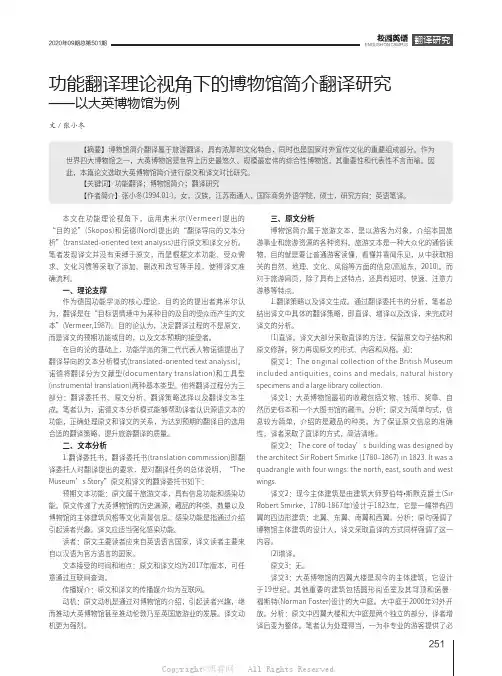
2512020年09期总第501期ENGLISH ON CAMPUS功能翻译理论视角下的博物馆简介翻译研究——以大英博物馆为例文/张小冬三、原文分析博物馆简介属于旅游文本,是以游客为对象,介绍本国旅游事业和旅游资源的各种资料。
旅游文本是一种大众化的通俗读物,目的就是要让普通游客读懂,看懂并喜闻乐见,从中获取相关的自然、地理、文化、风俗等方面的信息(高旭东,2010)。
而对于旅游网页,除了具有上述特点,还具有短时、快速、注意力游移等特点。
1.翻译策略以及译文生成。
通过翻译委托书的分析,笔者总结出译文中具体的翻译策略,即直译、增译以及改译,来完成对译文的分析。
(1)直译。
译文大部分采取直译的方法,保留原文句子结构和原文修辞,努力再现原文的形式、内容和风格。
如:原文1:The original collection of the British Museum included antiquities, coins and medals, natural history specimens and a large library collection.译文1:大英博物馆最初的收藏包括文物、钱币、奖章、自然历史标本和一个大图书馆的藏书。
分析:原文为简单句式,信息较为简单,介绍的是藏品的种类。
为了保证原文信息的准确性,译者采取了直译的方式,简洁清晰。
原文2: The core of today’s building was designed bythe architect Sir Robert Smirke (1780–1867) in 1823. It was a quadrangle with four wings: the north, east, south and west wings.译文2:现今主体建筑是由建筑大师罗伯特•斯默克爵士(SirRobert Smirke,1780-1867年)设计于1823年,它是一幢带有四翼的四边形建筑:北翼、东翼、南翼和西翼。
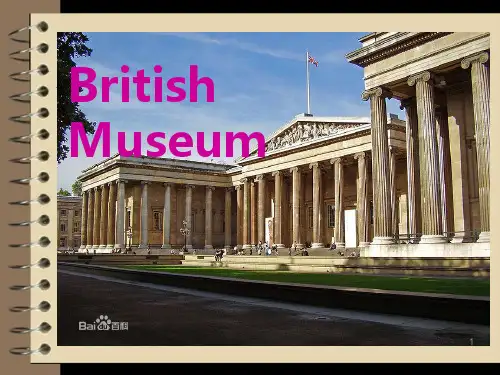
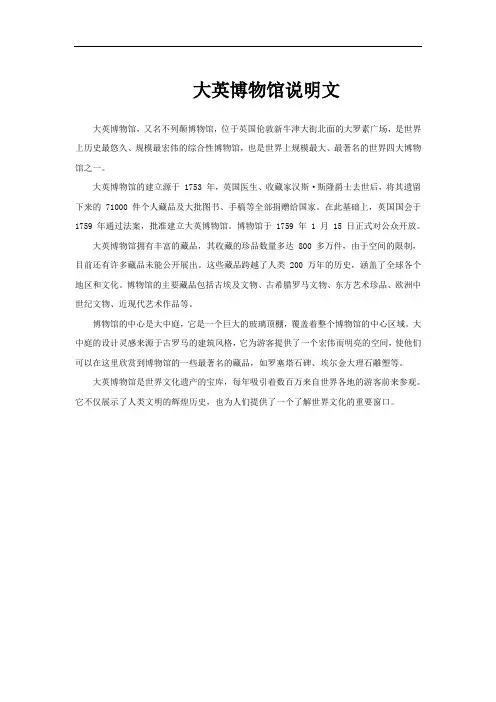
大英博物馆说明文
大英博物馆,又名不列颠博物馆,位于英国伦敦新牛津大街北面的大罗素广场,是世界上历史最悠久、规模最宏伟的综合性博物馆,也是世界上规模最大、最著名的世界四大博物馆之一。
大英博物馆的建立源于 1753 年,英国医生、收藏家汉斯·斯隆爵士去世后,将其遗留下来的 71000 件个人藏品及大批图书、手稿等全部捐赠给国家。
在此基础上,英国国会于1759 年通过法案,批准建立大英博物馆。
博物馆于 1759 年 1 月 15 日正式对公众开放。
大英博物馆拥有丰富的藏品,其收藏的珍品数量多达 800 多万件,由于空间的限制,目前还有许多藏品未能公开展出。
这些藏品跨越了人类 200 万年的历史,涵盖了全球各个地区和文化。
博物馆的主要藏品包括古埃及文物、古希腊罗马文物、东方艺术珍品、欧洲中世纪文物、近现代艺术作品等。
博物馆的中心是大中庭,它是一个巨大的玻璃顶棚,覆盖着整个博物馆的中心区域。
大中庭的设计灵感来源于古罗马的建筑风格,它为游客提供了一个宏伟而明亮的空间,使他们可以在这里欣赏到博物馆的一些最著名的藏品,如罗塞塔石碑、埃尔金大理石雕塑等。
大英博物馆是世界文化遗产的宝库,每年吸引着数百万来自世界各地的游客前来参观。
它不仅展示了人类文明的辉煌历史,也为人们提供了一个了解世界文化的重要窗口。
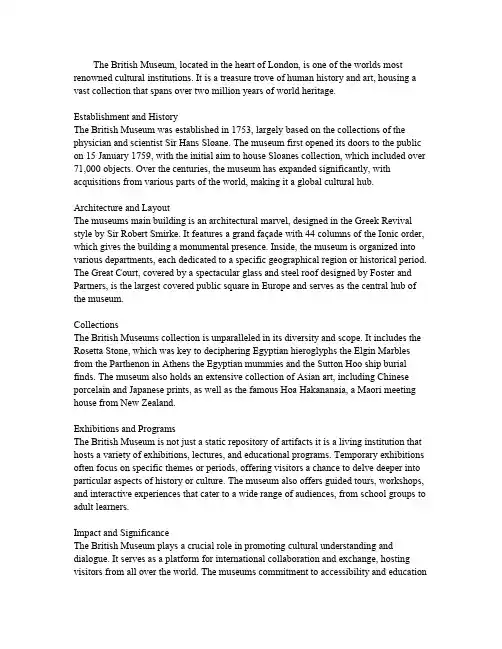
The British Museum,located in the heart of London,is one of the worlds most renowned cultural institutions.It is a treasure trove of human history and art,housing a vast collection that spans over two million years of world heritage.Establishment and HistoryThe British Museum was established in1753,largely based on the collections of the physician and scientist Sir Hans Sloane.The museum first opened its doors to the public on15January1759,with the initial aim to house Sloanes collection,which included over 71,000objects.Over the centuries,the museum has expanded significantly,with acquisitions from various parts of the world,making it a global cultural hub. Architecture and LayoutThe museums main building is an architectural marvel,designed in the Greek Revival style by Sir Robert Smirke.It features a grand façade with44columns of the Ionic order, which gives the building a monumental presence.Inside,the museum is organized into various departments,each dedicated to a specific geographical region or historical period. The Great Court,covered by a spectacular glass and steel roof designed by Foster and Partners,is the largest covered public square in Europe and serves as the central hub of the museum.CollectionsThe British Museums collection is unparalleled in its diversity and scope.It includes the Rosetta Stone,which was key to deciphering Egyptian hieroglyphs the Elgin Marbles from the Parthenon in Athens the Egyptian mummies and the Sutton Hoo ship burial finds.The museum also holds an extensive collection of Asian art,including Chinese porcelain and Japanese prints,as well as the famous Hoa Hakananaia,a Maori meeting house from New Zealand.Exhibitions and ProgramsThe British Museum is not just a static repository of artifacts it is a living institution that hosts a variety of exhibitions,lectures,and educational programs.Temporary exhibitions often focus on specific themes or periods,offering visitors a chance to delve deeper into particular aspects of history or culture.The museum also offers guided tours,workshops, and interactive experiences that cater to a wide range of audiences,from school groups to adult learners.Impact and SignificanceThe British Museum plays a crucial role in promoting cultural understanding and dialogue.It serves as a platform for international collaboration and exchange,hosting visitors from all over the world.The museums commitment to accessibility and educationensures that its collections are not only preserved but also made accessible to the public, fostering a deeper appreciation for the rich tapestry of human history.Visiting the MuseumVisitors to the British Museum are encouraged to explore its vast collections at their own pace.With free admission,the museum is a mustvisit destination for anyone interested in art,history,or culture.The museum also offers a range of services,including guided tours,a research library,and a shop that sells replicas of some of the most iconic artifacts in its collection.In conclusion,the British Museum is a testament to the enduring power of human creativity and the importance of preserving our shared cultural heritage.It stands as a beacon of knowledge and understanding,inviting visitors to step back in time and explore the wonders of the past.。
马未都大英博物馆里的中国宝藏文/马未都顶部由1656块玻璃片组成的“大中庭”位于大英博物馆的中心,这里是欧洲最大的有顶广场。
大英博物馆自开放以来,已经走过256周年,藏有各国珍品600多万件,其中中国文物2万多件。
公元1753年,英国医生汉斯· 斯隆爵士去世,享年94岁。
他不仅是一名著名的医生,更是一名大收藏家,他身后留下的收藏品达79575件之多,汉斯本想将收藏品捐给国家,但生前未能如愿,直到政府通过发行彩票筹得资金后,董事会购买了一座17世纪晚期的建筑作为馆址,汉斯的终生收藏才找到最好的归宿。
这就是大英博物馆的由来。
1759年的1月15日,大英博物馆首次向公众开放,拉开了英国博物馆的序幕。
从开放日计起,大英博物馆已经走过了250余年。
大英博物馆设有近百个展厅,囊括全世界各个地区的文化。
中国古代文化物证就静静地待在33号展厅,其面积与古埃及、希腊等最大面积的展厅平起平坐;它不以惯常的分类方法展出,而是按年代排列,让各国观众在中国古代文化物证中徜徉,纵向推进,横向比较,给好学者以提示,给好奇者以学养。
【粉彩花鸟扁壶】清雍正高29.3厘米这件扁壶以温和的粉彩、写实的画法,注重表现花卉的颜色盈泽和阴阳向背以及飞鸟羽翎的质感和色彩变化,整幅画面有点儿像苏州评弹,浅吟低唱,余音绕梁,非常优美;并以花枝上的两只白头翁,表达了“白头富贵”的美好愿望。
粉彩是中国陶瓷史上最后诞生的一个主要品种,它的出现打破了数百年以来青花的霸主地位。
【玉面神人像】新石器晚期宽5.8厘米它面方、嘴阔,长有獠牙;宽鼻、菱形眼,表情庄重;头戴冠帽、大耳戴环。
这件玉面神人像极可能发现于湖北省石家河遗址群,据推断是巫师通天时所佩戴的面具,代表着当地尊奉的神的形象,为宗教祭器,是神权的象征。
与同时期良渚文化及红山文化的玉器相比较,这件玉器在工艺上以剔地阳纹为特点,工序复杂,技艺更胜一筹。
【黄地青花四果石榴花盘】明宣德高5.5厘米口径29.5厘米中央为缠枝石榴花,四周分别为柿子、桃子、荔枝及樱桃四种果实的花枝。
走进大英博物馆摘要:建筑与文化关系密切。
古今中外的建筑艺术,无一不是和彼时代的文化精神一脉相承的。
文章从文化的角度出发,首先对大英博物馆作了简单介绍,然后着重对博物馆建筑以及大英博物馆特色建筑进行了详细的介绍和分析。
通过本文,带领大家解读博物馆建筑与文化之间的内在联系。
关键词:大英博物馆博物馆建筑建筑文化古典主义复兴风格1.引言人类学家爱德华·泰勒在1871年对文化是这样定义的:“从广泛的人种论的意义上说,文化或者说文明是指包括知识、信仰、艺术、道德、法律、风俗及社会成员所得到的其他能力和习惯的综合体。
”所谓建筑文化,是指通过建筑群体及其周围空间的设计所体现出来的建筑形态、建筑风格、建筑价值及人们对建筑的评欣赏、情感依附等文明因素的总和。
这种文化既是一种物质环境文化,同时也是一种依托物质环境所渗透、展示的特殊精神氛围文化。
建筑以及与建筑有关的一切人及人类活动、事物、现象之间是密切联系、相互作用的,它们都是建筑文化的重要组成部分。
著名的建筑学家梁思成先生曾做出过这样的论述:“一般地说,一座欧洲建筑,如同欧洲的画一样……”也有人则干脆把建筑比成了砖石叠成的史书。
人们或许不记得现任的法国总统,但不会不知道巴黎的凯旋门、卢浮宫;人们或许不清楚澳大利亚的首都是哪座城市,但不会不知道矗立在杰克逊海湾的悉尼歌剧院。
因为它们在展示美的同时,还担当了记载历史的重任。
2.大英博物馆简介大英博物馆又名不列颠博物馆,位于新牛津大街北面的大罗素广场,是世界上历史最悠久、规模最宏伟的综合性博物馆之一。
它与纽约的大都会艺术博物馆、巴黎的卢浮宫同列为世界三大博物馆。
该馆的主体建筑在伦敦的布隆斯伯里区,核心建筑占地约56000平方米,主要的附属建筑占地约30000平方米。
目前博物馆拥有藏品600多万件。
位于新牛津大街北面的大罗素广场,其藏品之丰富、种类之繁多为全世界博物馆所罕见。
图1-1 大英博物馆1759年1月5日,不列颠博物馆正式对外开放。